Weekly Arizona COVID-19 Data Report – Dr. Joe Gerald, May 7 Update
Note this forecast page is not the most recent forecast available.
View the most current forecast report
Researcher Analyzes Arizona COVID-19 Spread Models for Decision-Makers
The following information regarding the spread of COVID-19 in Arizona was prepared by Joe Gerald, MD, PhD, a researcher at the Mel and Enid Zuckerman College of Public Health (MEZCOPH) at the University of Arizona. This information has also been reviewed by other MEZCOPH faculty.
This data were obtained from the Arizona Department of Health Services COVID-19 webpage and reflect conditions in Arizona as of May 7, 2021.
This information is intended to help guide our response to the outbreak. It is not intended to predict how this pandemic will evolve. Rather, this model extrapolates what might occur if current conditions remain unchanged. As regional authorities and healthcare providers respond, their actions are expected to mitigate the worst consequences of this pandemic.

COVID-19 Disease Outbreak Forecast
Arizona State and Pima County
Updated May 7, 2021
Disclaimer: This information represents my personal views and not those of The University of Arizona, the Zuckerman College of Public Health, or any other government entity. Any opinions, forecasts, or recommendations should be considered in conjunction with other corroborating and conflicting data. Updates can be accessed at https://publichealth.arizona.edu/news/2021/covid-19-forecast-model.
For the week ending May 2nd, 4946 Covid-19 cases were diagnosed representing a 4% decrease from last week’s initial tally of 5141 cases (Figure 1). This marks the first decline since March 21st. Case rates among those ≥65 years of age remain the lowest of any age group at 26 per 100K residents per week (Figure 2). The highest rates are among those 15 – 24 years of age at 111 cases per 100K residents per week.

|
Figure 1. Newly Diagnosed Covid-19 Cases in Arizona and Number of Individuals Undergoing Covid-19 Diagnostic Testing March 1, 2020 through May 2, 2021. |
Overall, cases are being diagnosed at a rate of 68 per 100K residents per week. For reference, September 8th marked the fall nadir between the summer and winter outbreaks at 38 cases per 100K residents per week. The post-holiday nadir was 54 cases per 100K residents on March 23, 2021. Case rates will likely remain “stuck” above the threshold differentiating substantial and moderate risk, 50 cases per 100K residents per week, for the next 4 – 6 weeks owing to more transmissible variants (e.g., B.1.1.7) and continued normalization of behaviors.
According to the CDC, vaccination rates continue to increase, albeit more slowly, with 39% of Arizona’s adult population being fully vaccinated and another 14% having received one dose (53% with ≥1 doses). With only 65% of its ≥65 population being fully vaccinated, Arizona ranks 40th among the states. Unvaccinated adults who are at risk of developing severe disease (e.g., advanced age or comorbid conditions) or those who simply wish to remain uninfected should continue to follow recommended precautions as viral activity remains widespread.
Note: Data for this report was updated Friday, May 7 allowing 4 full days to adjudicate cases and keep week-over-week backfill 10%. This allows more interpretable comparisons and graphics. All comparisons are week-over-week changes.
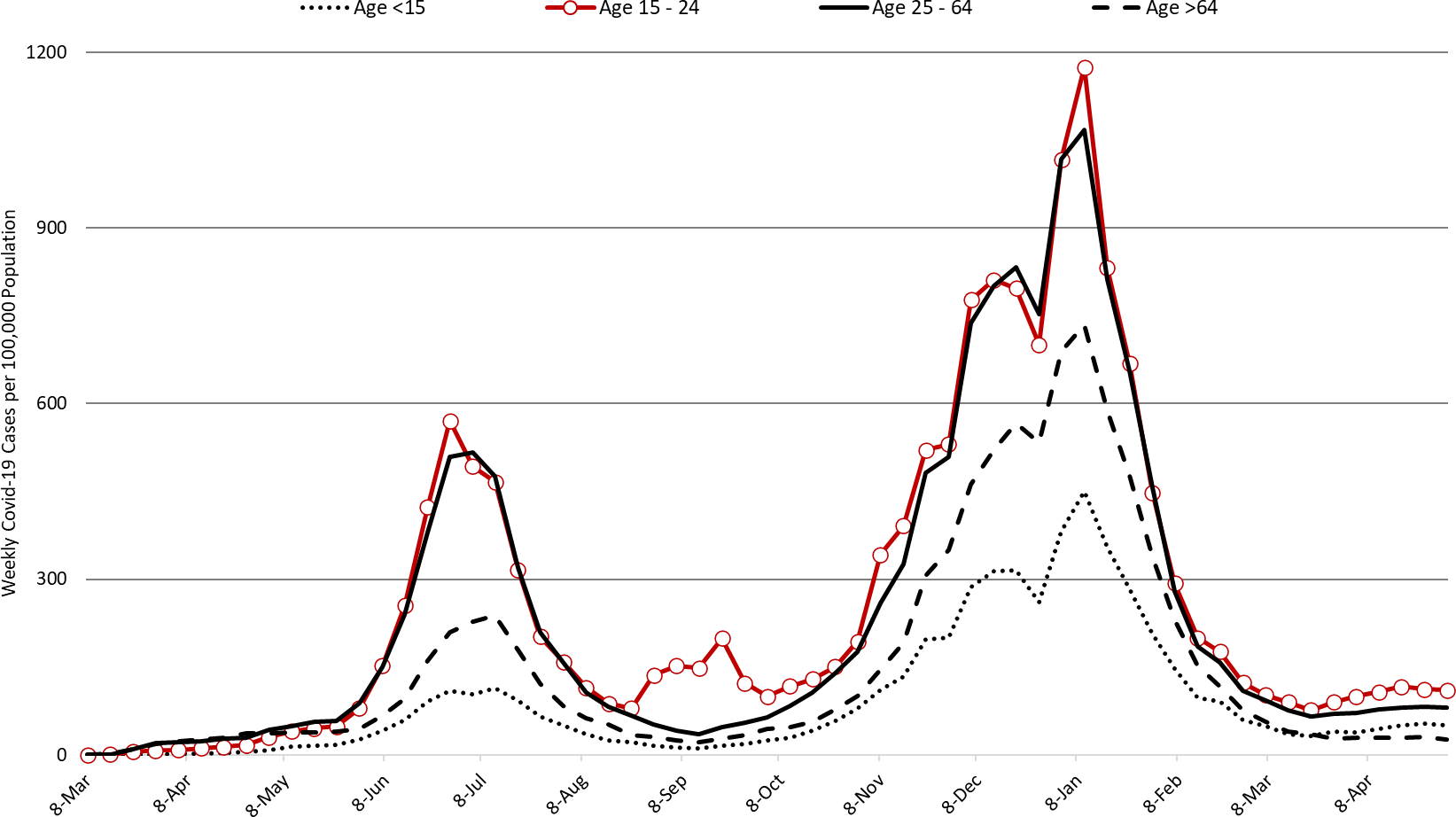
|
Figure 2. Newly Diagnosed Covid-19 Cases in Arizona by Age Group March 1, 2020 through May 2, 2021. |
Test positivity among those undergoing traditional nasopharyngeal PCR testing has plateaued at 10%, remaining within the 5 – 10% window for optimal public health practice (Figure 3).
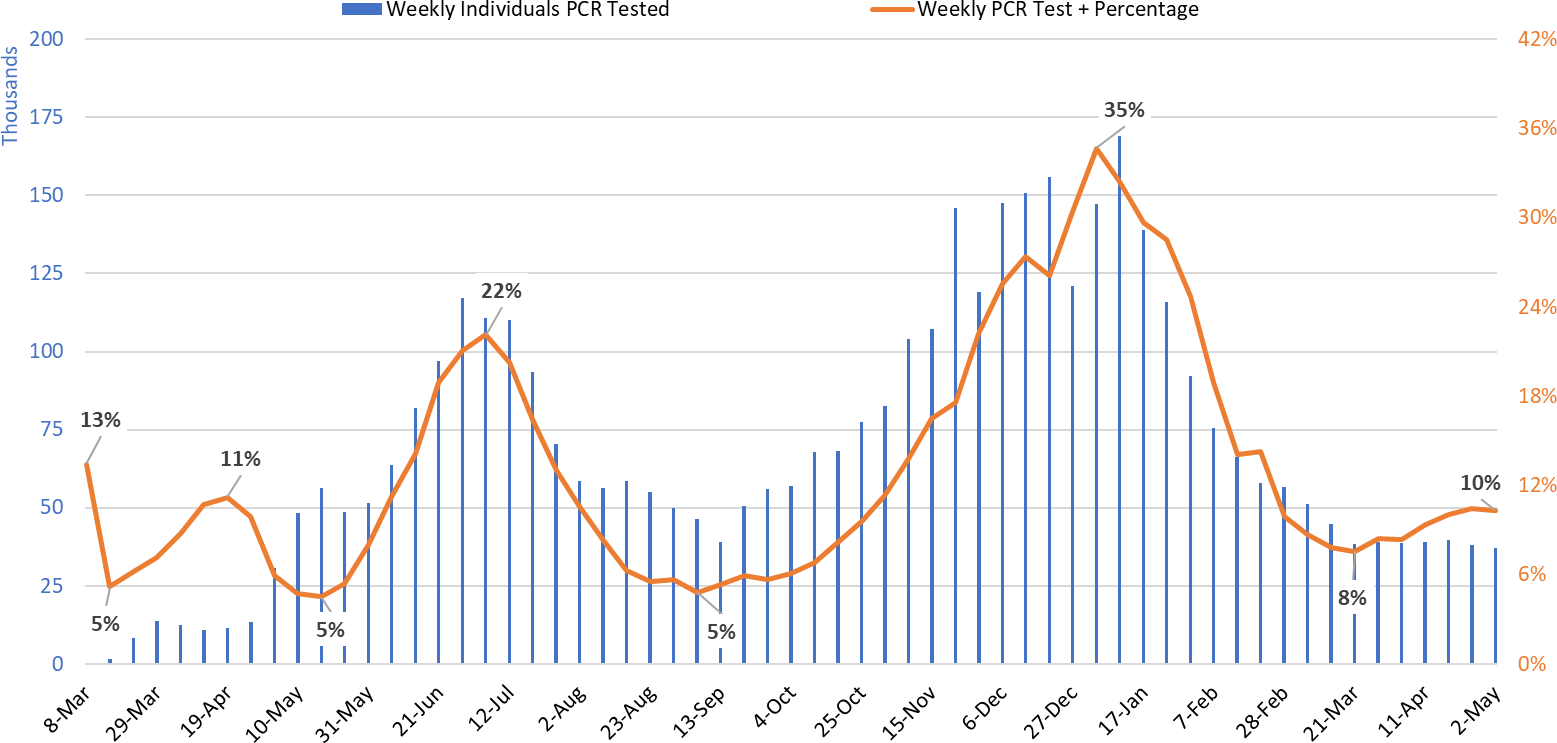
|
Figure 3. Weekly Number Patients Undergoing Traditional Nasopharyngeal PCR Testing and Associated Percent Positivity March 1, 2020 – May 2, 2021. |
As of May 6th, 666 (8%) of Arizona’s 8600 general ward beds were occupied by Covid-19 patients, an 8% increase from the previous week’s 618 occupied beds (Figure 4 and Figure 5 Panel A). Another 919 (11%) beds remained available for use. The number of available beds is lower than the previous week’s 984 beds.
The summer-fall nadir was 468 occupied beds on September 27th. The post-holiday nadir was 516 beds on April 4.
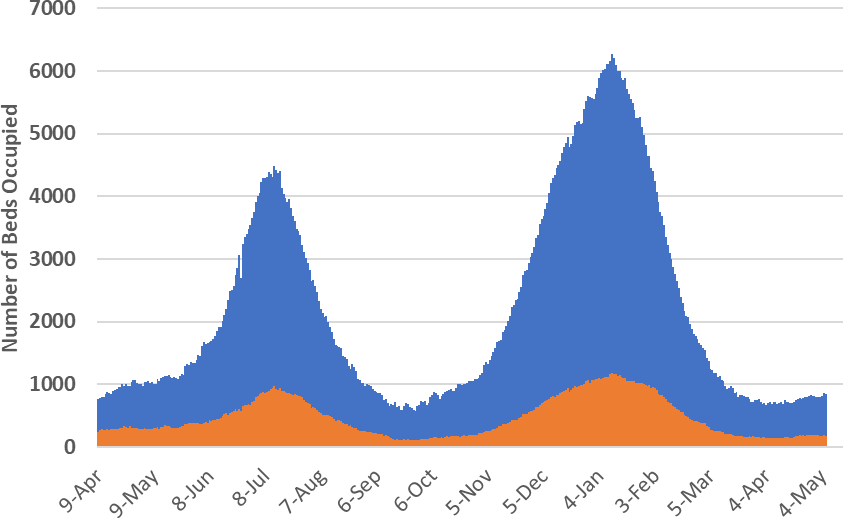
|
Figure 4. Arizona Daily Covid-19 General Ward and ICU Census April 9, 2020 – May 2, 2021. |
As of May 6th, 182 (11%) of Arizona’s 1731 ICU beds were occupied with Covid-19 patients, a small decrease from the prior week’s count of 189 patients (Figure 4 and Figure 5 Panel B). An additional 236 (15%) ICU beds remained available for use. This is similar to the prior week’s 237 available beds. The summer-fall nadir was 114 occupied beds on September 22nd. The post-holiday nadir was 140 beds on April 7th.
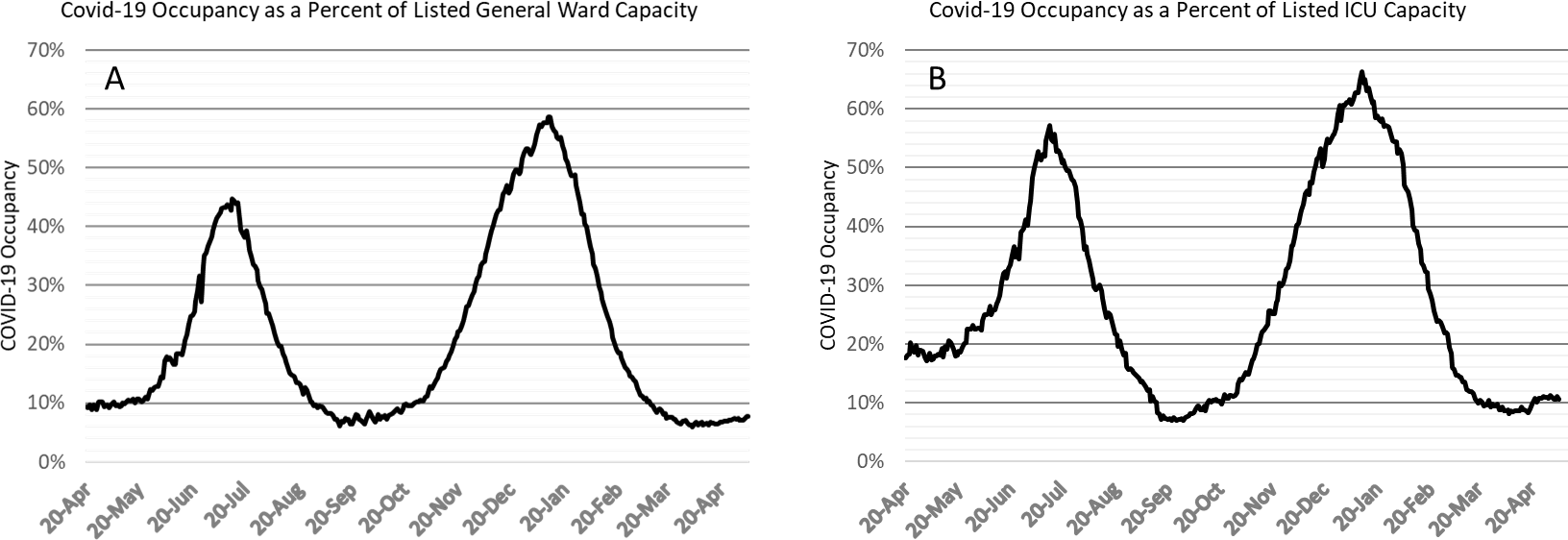
|
Figure 5. Covid-19 Occupancy as a Percent of Listed General Ward (A, left) and ICU (B, right) Capacity in Arizona April 20, 2020 – May 2, 2021. |
Arizona hospital occupancy remains above seasonal levels. Improvements in ward and ICU occupancy have stalled at ≥85% occupancy (Figure 6). This indicates that medically necessary procedures that were previously postponed are being scheduled at higher than seasonal amounts to address the backlog of care. It will still take several more months to resolve. Occupancy will need to fall 70-75% before conditions will be back to “normal.” As capacity constraints are lessened, care practices should return to those prior to the outbreak ensuring all patients will receive optimal care. Hospitals will remain crowded through May - June before returning to pre-outbreak levels.
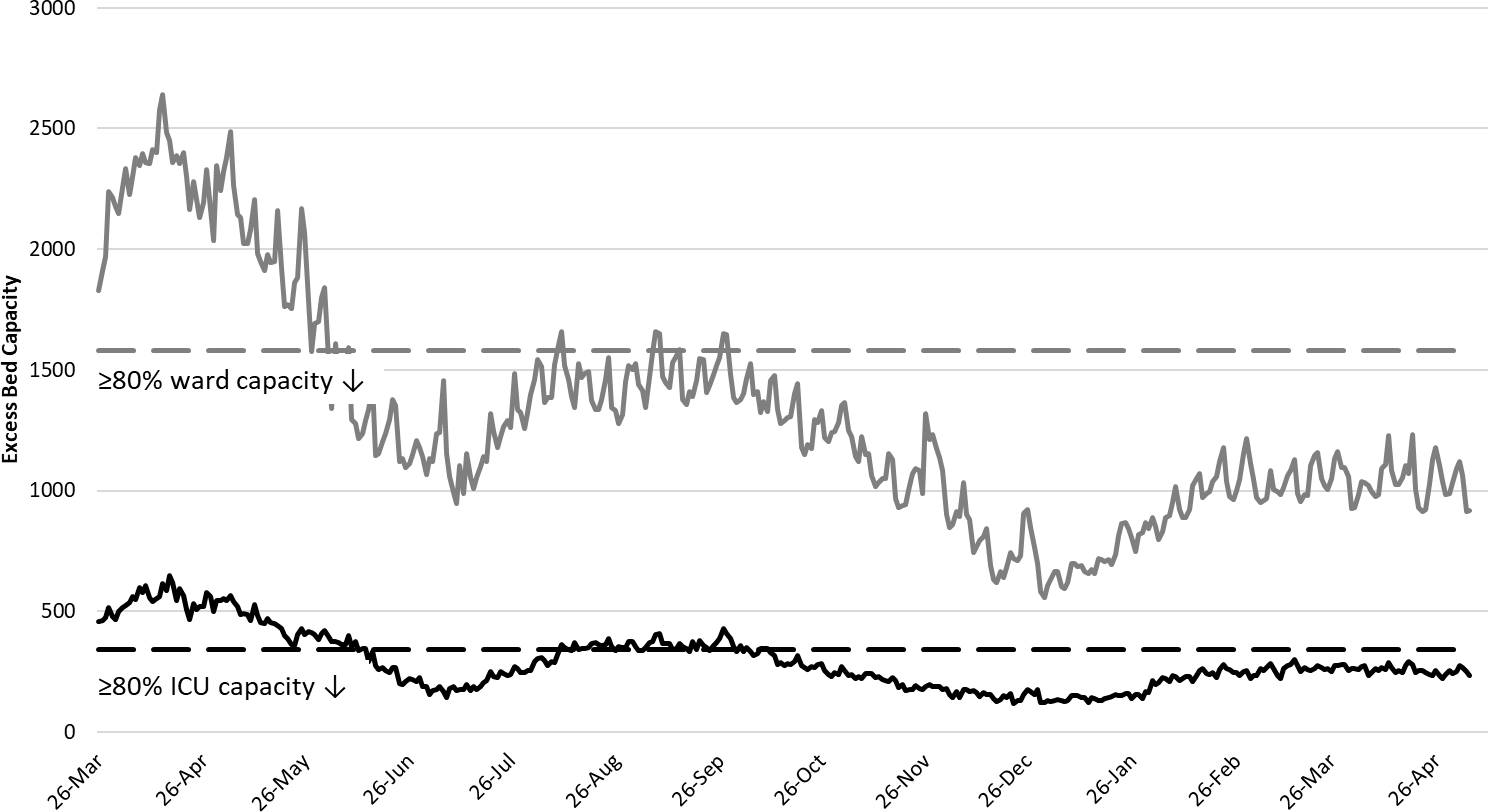
|
Figure 6. Observed Excess Non-Surge General Ward and ICU Capacity March 26, 2020 – May 2, 2021. |
The week ending January 17th remains Arizona’s deadliest with 1089 deaths (Figure 7). With 73 deaths recorded on March 28th, it is the first week with 100 Covid-19 deaths since October. The summer – fall nadir was 51 deaths the week ending October 4th.
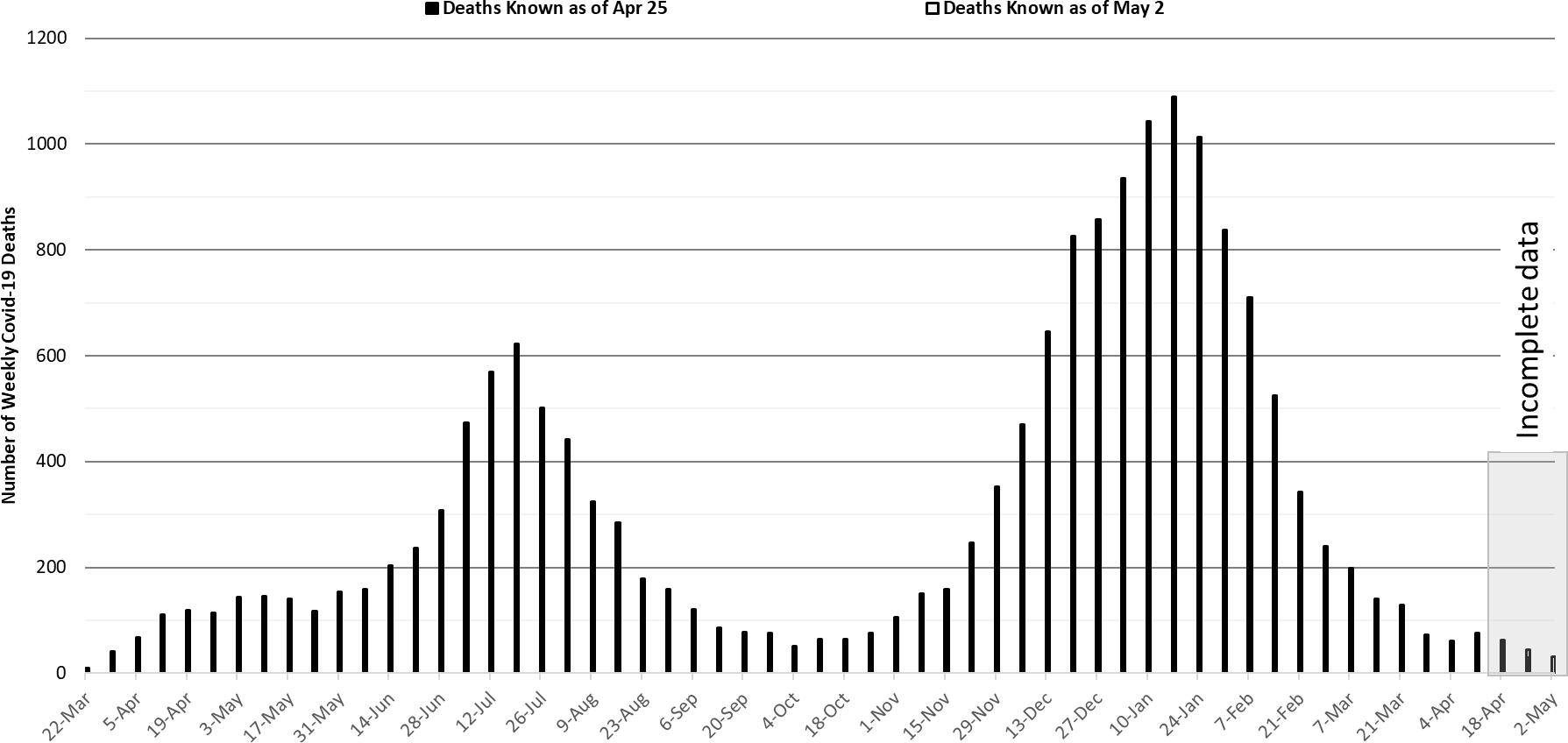
|
Figure 7. Weekly Arizona Covid-19 Deaths March 16, 2020 – May 2, 2021. |
Pima County Outlook
For the week ending May 2nd, 430 Pima County residents were diagnosed with Covid-19 (Figure 8). This is a 1% increase from the 425 cases initially reported last week.
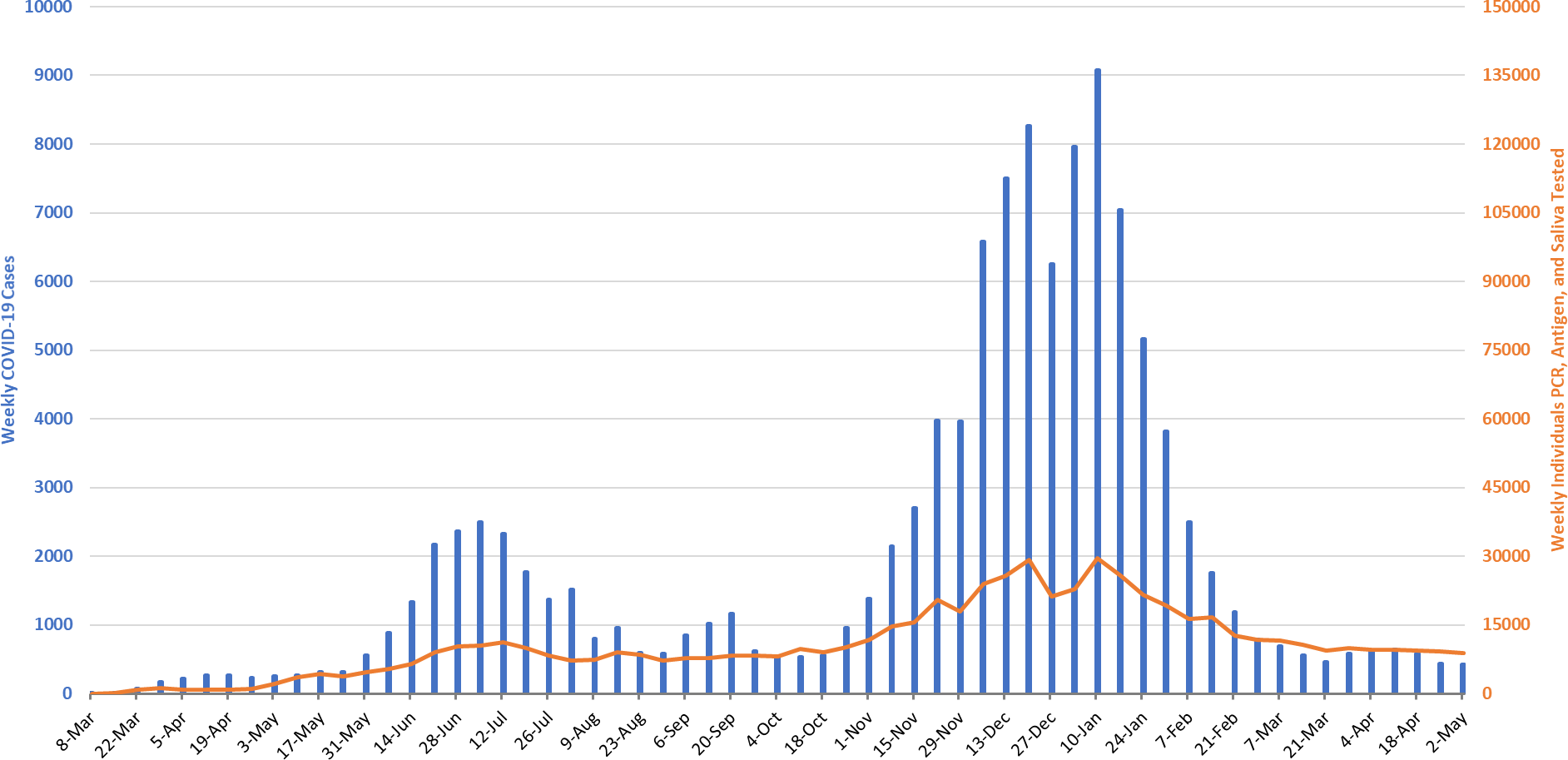
|
Figure 8. Covid-19 Cases and Individuals Undergoing Testing in Pima County Mar 1, 2020 – May 2, 2021 |
New cases are being diagnosed at a rate of 41 cases per 100K residents per week, the lowest rate since May 28th, 2020. October 9th marked the summer - winter nadir at 46 cases per 100K residents per week and March 20th marked the prior post-holiday nadir at 44 cases per 100K residents per week. Trends across the various age groups appear in Figure 9.
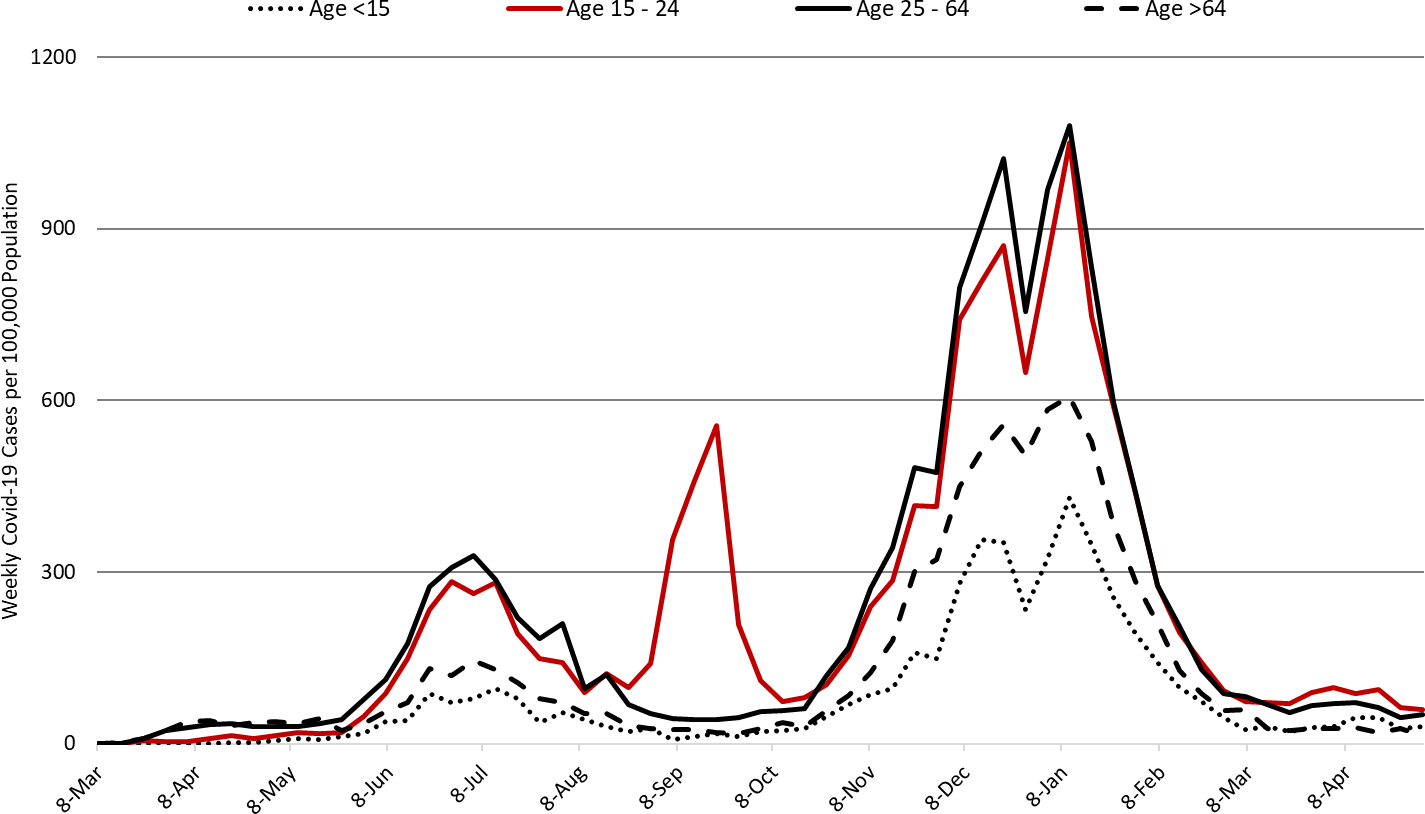
|
Figure 9. Covid-19 Cases by Age Group in Pima County from March 1, 2020 – May 2, 2021. |
Summary
- Covid-19 cases and hospitalizations are little changed over the past two weeks. We can expect similar levels of viral transmission for the next 4 – 6 weeks before rates begin to substantially improve (see updated ASU COVID-19 model in Appendix).
- As of May 2nd, new cases were being diagnosed at a rate of 68 cases per 100,000 residents per week. This rate is slowly decreasing by 2 - 3 cases per 100,000 residents per week.
- Test positivity for traditional nasopharyngeal PCR testing is holding steady at 10% which is within the recommended 5 – 10% range for optimal public health practice.
- Hospital Covid-19 occupancy is slowly increasing in the ward and ICU. Access to care remains somewhat restricted as overall occupancy remains unseasonably high (85%) while the backlog of medically necessary non-Covid procedures is being addressed.
- Arizona Covid-19 fatality counts are now 100 deaths per week should hover ≤75 deaths per week (5000 weekly cases x a 1.5% case fatality rate) for the next 4 – 6 weeks.
- According to the CDC, 39% of Arizona adults have received at least 2-doses of vaccine while another 14% have received 1-dose. Arizona passed peak vaccination rates in early April so progress towards our goal of >80% vaccinated is slowing.
Reading of Interest this Week:
- Abu-Raddad. Effectiveness of the BNT162b2 Covid-19 Vaccine against the B.1.1.7 and B.1.351 Variants. New Engl J Med. 2021; DOI: 10.1056/NEJMc2104974 (See link)
- Borchering RK. Modeling of Future COVID-19 Cases, Hospitalizations, and Deaths, by Vaccination Rates and Nonpharmacological Intervention Scenarios – United States, April – September 2021. MMWR. 2021; May 5, Vol 70. (See link)
- Sadoff J. Safety and Efficacy of Single Dose Ad26.COV2.S Vaccine Against Covid-19. New Engl J Med. 2021; DOI: 10.1056/NEJMoa2101544. (See link)
- See I. US Case Reports of Cerebral Venous Sinus Thrombosis with Thrombocytopenia after Ad26.COV2.S Vaccination, March 2 to April 21,2021. JAMA. 2021; oi:10.1001/jama.2021.7517. (See link)
- MacNeil JR. Updated Recommendations from the Advisory Committee on Immunization Practices for Use of the Janssen (Johnson & Johnson) COVID-19 Vaccine After Reports of Thrombosis with Thrombocytopenia Syndrome Among Vaccine Recipients – United States, April 21. MMWR. 2021; 70 (17, April 30): 651 - 656. (See link)
The next and last update is scheduled for May 21st.
Forecast reports to date, available as PDFs
Download PDF to view additional charts of Arizona counties, available in appendix of report.
May 7
2020 Reports
Based on what we know now about this pandemic, we support guidelines for social distancing to slow the spread of the virus and urge everyone to follow the recommendations provided by the Centers for Disease Control and Prevention (CDC) to protect yourself, your family, your neighbors, and your employees. Please heed the recommendations as provided by the CDC, found at the following website: https://www.cdc.gov/coronavirus/2019-ncov/prepare/prevention.html
COVID covid coronavirus virus covid19 corona forecast model

